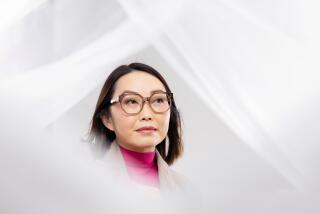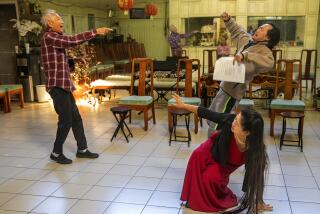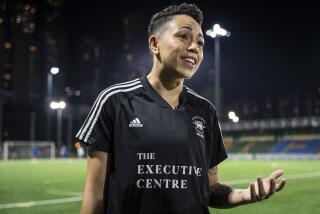Arts & Culture on the Pacific Rim : A Special Report : Hong Kong School Breaks Down Cultural Barriers
- Share via
HONG KONG — The British Crown Colony of Hong Kong is racing toward its prearranged remarriage to the rest of China at the end of the 20th Century with a surge of frenzied building. Everywhere one looks, construction cranes tower over the bamboo scaffold-clad shells of buildings-in-progress. It is difficult to pick out a building on either side of the harbor that is more than 10 years old.
One of them is the Hong Kong Academy for Performing Arts, a squat, but not unattractive compilation of gray concrete nestled in the foreground of the architects’ smorgasbord of steel, glass and tile towers that is part of the island’s waterfront panorama.
The academy, like most of its neighbors, is young--soon to celebrate its fourth birthday. Land for the sprawling three-building complex--a filled-in area over the city’s major sewer channel--was given by the Hong Kong government, also the source of an annual maintenance allotment. The Royal Hong Kong Jockey Club, owners and operators of the colony’s two race tracks, financed the $39-million construction.
As in the rest of the colony, there is wide speculation at the academy over what will become of Hong Kong, home of one of the world’s most intensely business-oriented cultures, when it becomes part of the Peoples’ Republic of China in 1997, at the end of Britain’s 99-year lease. The proven tendency for political winds in China to shift rapidly lends plausibility to almost any conjecture.
“The Chinese are very big on education,” Carl Wolz, dean of the academy’s school of dance said in a recent discussion. “You can be sure they will pay serious attention to the APA and will probably bring in their own people to run it right from the start.”
Concern about the institution’s future has little visible effect on its present burgeoning activities.
Wolz’s school is one of four distinct schools, of dance, drama, music and technical arts, which make up the APA. The divisions function in fully equipped, state-of-the-art facilities. There are specially designed, soundproofed classrooms, large, airy teaching and rehearsal studios, a professional television studio, a recording setup capable of producing high-quality tapes or records, and scenery and costume shops, and performing venues ranging from a 1,200-seat theater, and a 500-seat outdoor amphitheater, to a 100-seat recital hall.
“The idea here is cooperation,” Wolz points out. “The students each specialize in one of the disciplines, but we do our best to make sure they have a practical understanding of what goes on in the other disciplines.’
Missouri-born Wolz is a former dancer, and an expert in a wide variety of Asian dance. He taught dance at such schools as Juilliard, the University of Hawaii, and UCLA before being selected to direct the academy’s dance program.
The interdisciplinary approach is more than a progressive theory, school administrators point out. The academy’s purpose, they say, is to produce professional performers and teachers in a world where the artificial boundaries between the various areas of the performing arts are melting rapidly. Students are required to take courses in divisions other than their own. For instance, musicians study movement, and dancers study drama. All performers are expected to acquire some technical production skills.
Artistic boundaries are not the only ones the academy seeks to dissolve. The three performing arts divisions try to prepare students to go beyond cultural barriers as well, with classes concentrating on both traditional Chinese and Western approaches to the art forms.
The academy’s dance program is divided into three major fields, with students being offered the choice of pursuing traditional Chinese dance, classical ballet, or modern dance. The Chinese dance line includes both folk styles and the acrobatics popularized by more recent touring troupes.
There is also an effort to expose students to a wide spectrum of dance from other countries. Under Wolz’s administration, the school of dance has hosted the International Festival of Dance Academies--with participants from Australia, China, England, Japan, Taiwan, the U.S. and other countries--every year since the academy opened in 1985.
The modern dance area covers the widest stylistic range. According to Jan Day, former head of the dance department at Cal State L.A., now at the academy as a guest senior lecturer in modern dance, the multiplicity of teaching styles and choreographic modes to which the students are exposed gives rise to artistic flexibility. “The mix here is incredible,” she says. “These kids are theoretically able to tackle any style. They get Martha Graham and Jose Limon techniques, contact improvisation and much more. There are different guest teachers--such as myself--here every year.”
In addition to the guest residency programs, there are short workshops and seminars offered to the students. A recent workshop in “physical theater,” a merging of modern theater techniques with dance-based movement, brought together young participants from all three dance disciplines as well as from the School of Drama.
“We like to encourage that kind of exploration,” says Chung King Fai, dean of the school of drama at the academy and a Yale University graduate. “It is important that these students are familiar with more than just one system of theater.”
Productions by the academy’s drama students--usually performed in Cantonese--range from Chinese plays such as “The Story of Ah-Q” and “Voyage of the Stone,” through “Merchant of Venice,” “Marat / Sade,” and “Children of a Lesser God.”
The mixture of East and West which is Hong Kong is also reflected in the school of music. The school is divided into a Chinese music department, in which many regional traditions of instrumental and vocal music are taught and preserved, and a Western music division, where classical and modern European and American composers are studied. Last season the school presented a fully staged production of Mozart’s “Magic Flute” sung in English. It is that kind of interdisciplinary project which the Academy’s administrators hope to see more of in the future.
That future may be unpredictable, both for Hong Kong and for its Academy for Performing Art, but that doesn’t seem to faze the academy’s students or faculty. They go on creating and planning; building for whatever that future may bring.
More to Read
Sign up for Essential California
The most important California stories and recommendations in your inbox every morning.
You may occasionally receive promotional content from the Los Angeles Times.










